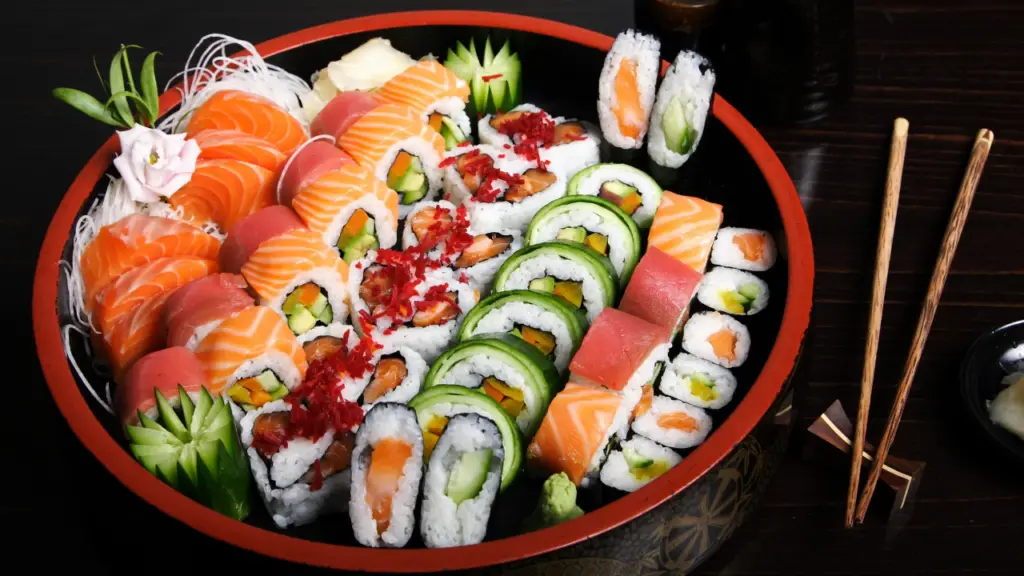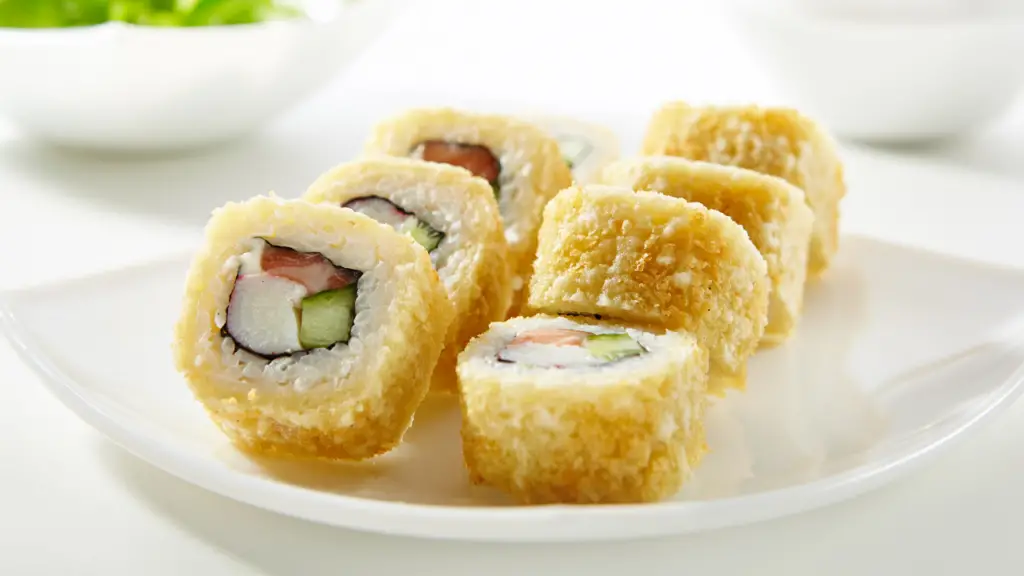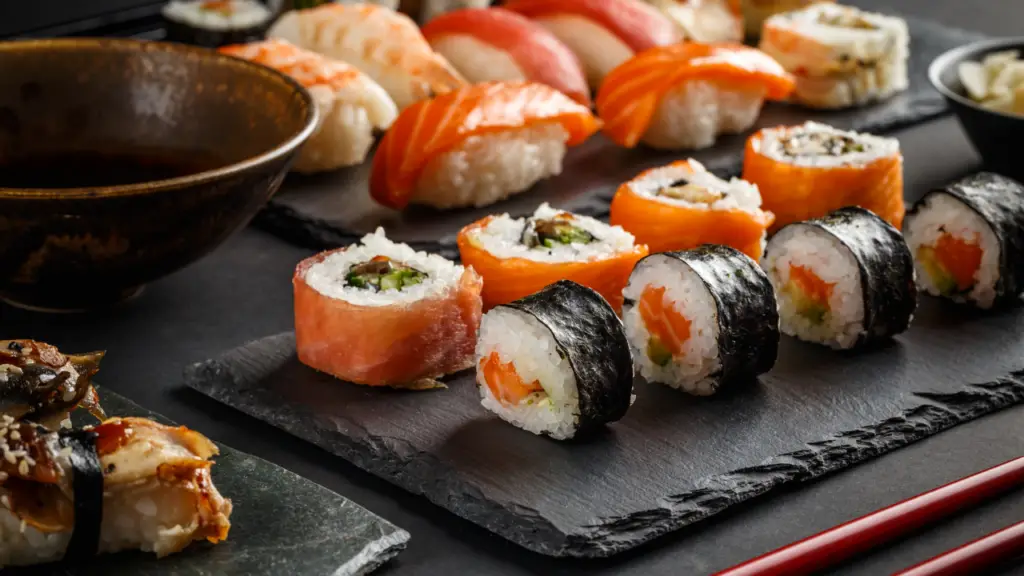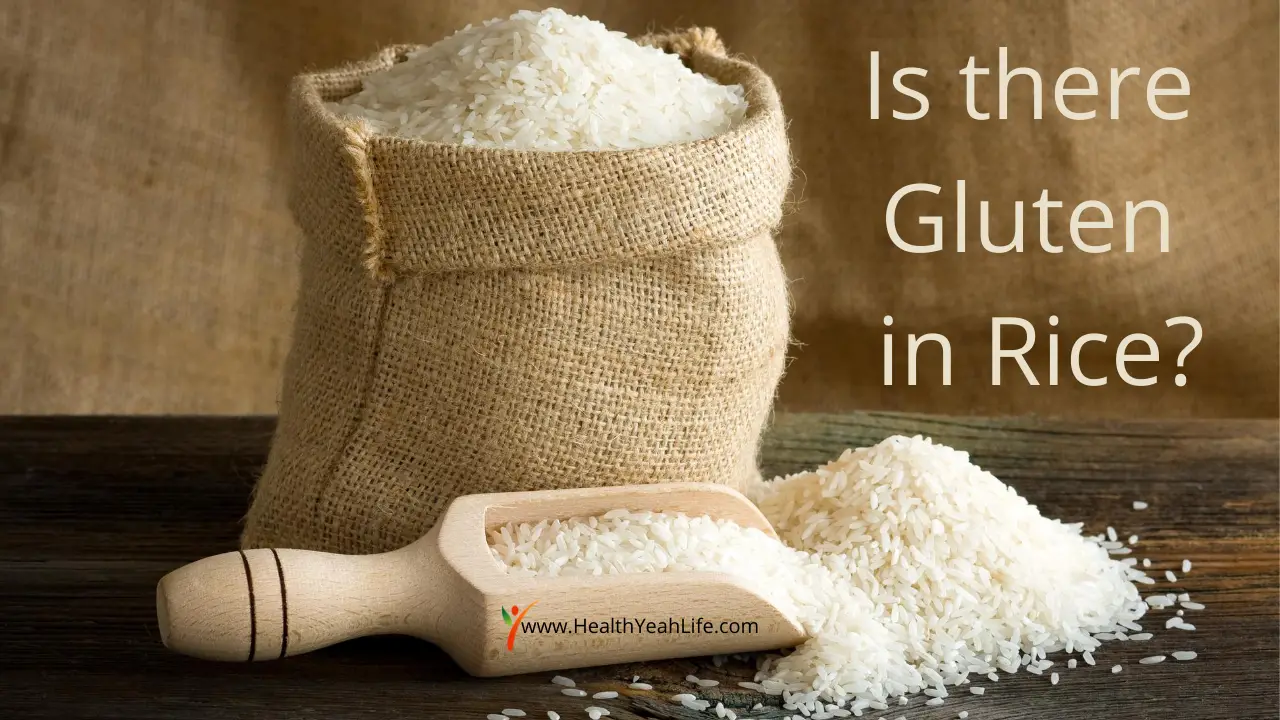It all started with a small Japanese stall owner who had the idea of wrapping fish in rice. Today it's a favorite quick-bite fast food with tons of fillings and toppings. This modern Japanese food isn't any less prevalent in the United States either.
For gluten-free dieters, any food needs to be dissected for gluten risks. So, can you eat sushi on a gluten-free diet? Our guide will tell you all about it!
What is Traditional Sushi?
Although it is Japanese cuisine, this delicious dish is now being served worldwide, even in grocery stores. It's almost irresistible to say no, too, considering the perfect harmony of tastes. But many people don't understand the dish technically. If you're planning on spending your vacations in Japan or just curious, here's your guide to sushi and gluten.

Surprisingly, sushi doesn't have to be raw fish. The main ingredients in sushi is a broad category of food in which vinegar-seasoned rice is served with vegetables, fish, or other seafood.
Most people prefer their fish to be raw. Although, some don't, and there are types of sushi made using cooked eel or shrimp. The rice is the most critical ingredient. And to learn it to perfection, Japanese chefs spend years in training and learning. Here are some different types of sushi:
Nigri sushi:
Nigri sushi is probably one of the most flavorful experiences you'll ever have. A slice of raw fish, such as bluefin tuna or salmon, laid over a mound of sweet and salty rice can give an excellent mouthfeel.
Maki sushi:
In this type, the fish and rice are rolled together in a sheet of seaweed called nori. It is an American favorite.
Sashimi and its misconception:
Many people consider sashimi a type of sushi as well, while some even consider Nigri and Sashimi to be the same. Sashimi is prepared using raw fish and soy sauce. But without the rice to bolster the flavor of the fish, sashimi can't be considered sushi.
Gluten and Celiac Disease
Celiac disease is caused by gluten, which is a type of protein found in some dietary sources such as wheat, barley, and rye. Under normal conditions, eating gluten doesn't hurt. But not everyone responds to gluten in such a way, or in other words, doesn't react to gluten. Some people have a predisposition to developing severe gastrointestinal symptoms whenever they eat gluten. A bowl of cereal can cause extreme diarrhea.

Meanwhile, eating a loaf of bread may lead to acute constipation and bloating. These people suffer from a medical condition called celiac disease. It is where the immune system causes an autoimmune disorder, and a celiac patient reacts violently to gluten.
According to experts, whenever celiacs eat more than 20ppm gluten, the body starts to produce antibodies. These antibodies have the task of destroying gluten. However, in doing so, they also end up damaging the lining of the small intestine. As a result, the patient complains about any of the various gastrointestinal symptoms. Repeated exposure to gluten keeps damaging the small intestine and can also lead to other complications.
Is a Gluten-Free Diet Necessary?
The only treatment available is avoiding the cause. All the food items incapable of triggering the symptoms of a celiac patient are called a “gluten-free diet.” These food items aren't strictly speaking gluten-free but contain gluten in an amount less than 20ppm. But this amount is so minimal that calling it's appropriate to call these dietary sources gluten-free.
Since continuously eating gluten keeps damaging the gut, it can only heal once the patient starts a gluten-free diet. After several months, the lining of the small intestine returns to its normal condition. Once this happens, the patient is relieved of their symptoms.

Sometimes, people suffer from other medical problems that seem unrelated to gut and digestive health. Following a gluten-free diet also helps in treating many problems. Some of these include iron deficiency anemia, yeast infection, dark circles under the eyes, and even certain skin conditions.
Studies have found gluten to cause these problems in celiac patients either directly or indirectly. Therefore, it is vital to follow a gluten-free diet if you're diagnosed with celiac disease. It's both treatment and prevention.
Gluten and Sushi
You now know that gluten is present in wheat, barley, and rye, in addition to certain additives. But it can weave its way into many naturally gluten-free food items unnoticed. Some types of sushi are included in the list of things that have to be dropped by celiac patients, but what if you are a sushi lover.
Fish, rice, and vegetables are naturally gluten-free. Since most types of sushi use these ingredients only, it is fair to assume that sushi is also gluten-free. It's how sushi can be and is contaminated by gluten, and we must always be on the lookout for hidden gluten.
Imitation Seafood:
Sometimes, sushi is prepared using imitation crab meat or surimi instead of a real crab. It's prepared by binding ground white fish with starch and other ingredients. Then, it is flavored to taste just like a real crab.
Many remain unaware that the starch used to bind the fish contains wheat. Because of this wheat, sushi containing surimi, such as California rolls, is not considered safe for celiac patients.
Tempura:
The ingredients of some sushi rolls, such as meat and vegetables, are dipped in tempura batter for added crunchiness. The tempura used to make this batter is made from wheat.

These sushi rolls can catch the eye from afar, making it reasonably easy to avoid them. Some gluten-free restaurants make a wheat-free batter for their celiac customers.
Soy Sauce:
The soy sauce used to make marinade contains gluten that can trigger the symptoms of a celiac patient. Most, if not all, of the soy sauces are made of wheat. The fish, usually salmon or tuna, used in some sushi rolls has to be marinated.
Thus, the marinated fish becomes a source of gluten. Again, sometimes the marinade is prepared using teriyaki sauce, which is made from soy sauce.
Wasabi:
Traditionally, sushi is made using a green paste called wasabi. Real wasabi is made from the rhizome of the Wasabia japonica plant. In the US, though, many restaurants do not use this ingredient. They make a mixture of horseradish, mustard, green food coloring, and other ingredients to make fake wasabi. It doesn't happen that often, but sometimes, wheat is also used.

Udon and Ramen Noodles:
These contain gluten and are frequently used to make sushi. Sometimes, a chef might use panko, a wheat-based breadcrumb, and beer, or as the Japanese call it, happoshu.
Cross-Contamination:
Even if something is made from gluten-free ingredients, there's always the risk of cross-contamination. Unless there's a separate kitchen devoted to making gluten-free items, eating from restaurants is a significant risk.
Dedicated gluten-free restaurants need to use different, clean cooking utensils that are safe from gluten. Despite the fact the sushi is made from gluten-free ingredients, shared kitchenware makes cross-contamination an increased possibility.
According to experts, even the same cutting board used for making various sushi rolls can increase cross-contamination risks. Unless the chef takes the responsibility of gluten-free sushi with a certified label, it is better to steer clear.
Potential Gluten-Based Ingredients:
Among potential gluten-containing ingredients, miso soup and green tea top the list as both of them may contain barley. If you're wondering what green tea might be doing in sushi, it's not a typical ingredient in traditional versions.

Instead, it helps reduce the bitterness that isn't usually tolerated by Western palates. Soba noodles aren't 100 percent buckwheat, and their water might be contaminated. Brown sauces and dumplings are also a potential source of gluten.
Sometimes, sushi rice can also be contaminated by using vinegar. Non-distilled white vinegar is either made from corn or wheat. If it is wheat-based, it will be the reason why your sushi contains gluten.
Tips on Ordering Gluten-Free Sushi
Whether you decide to take that trip to Japan or want to try out a local sushi restaurant, you can't compromise on your gluten-free diet. You can follow these tips to help you in ordering your gluten-free sushi.

Calling the Restaurant Before:
It is a good idea to call ahead and check their ingredients list and whether a gluten-free option is available or not. While talking to the representative, you'll get a basic idea about the restaurant's familiarity with accommodating gluten-free customers. If they seem reluctant or hesitant, you might want to try another restaurant.
Etiquette Issues:
Every culture has its norms and traditions that differ from other cultures. A chef has every right to be offended in Japanese culture when questioned about the ingredients' quality. They also consider it rude if someone inquires about the method of preparation.
While making sure your sushi is gluten-free, you need to ask the chef about the ingredients and preparation method. Make sure that you ask politely and respectfully and don't make a scene. If you're visiting a local restaurant, they are a bit used to accommodating diners with various food allergies. But still, this issue has to be handled delicately and with care.
Watch Your order Getting Prepared:
If you fear that your order might become subject to cross-contamination, you are able to see your order being prepared by a sushi chef. Some sushi restaurants have a see-through glass prep area or a sushi bar. It ensures that their customers can have a peek while their order is being prepared.

In this way, you can have a close look at all the ingredients used. Make sure your chef is using separate cutting boards, knives, and gloves that are properly sterilized. If these practices aren't being followed, you can politely request and even ask for a separate preparation area.
Bringing Your ingredients:
If you're not comfortable relying on the restaurant's gluten-free substitutes, bring your own. Some sushi places allow this, while others don't, so check before doing so. Sushi rice, vegetables, nori, non-marinated fish, and real crab meat are the naturally gluten-free ingredients used in sushi.
As for the other ingredients, most restaurants allow their customers to bring their ingredients with them. If that's the case, replace the fake or imitation crab with a fish of your choice. Some people even prefer adding avocado to their sushi! A lump crab or shrimp is an option too. If you have your own gluten-free soy sauce at hand, there's nothing better than that.
Soy sauce can easily step in to replace typical soy sauce, teriyaki sauce, or Asian pesto sauce. If gluten-free soy sauce isn't available, you can even squeeze a lemon for a similar taste. Gluten-free tamari sauce and coconut aminos are also a great alternative to soy sauce. Some Japanese restaurants even have their stock of gluten-free soy sauce. You can bring your gluten-free wasabi and use pickled ginger to flavor your rolls.
Self-Inspection:
Anything that's stir-fried or deep-fried will be a source of gluten. Before you eat, make a quick inspection of the menu, and inquire about any unexpected ingredients.
Leave the Food:
If you feel an unexpected crunch in your bite, stop eating and leave the food as it is. The only crunchy ingredients in sushi are either panko or tempura, and both are a source of gluten.
Final Words
We've concluded that sushi and a gluten-free diet can work well together. All you've to do is tweak a few ingredients here and there, and it's the perfect companion to the diet. If you haven't tried sushi yet, you should.
There's a reason it has gathered so many lovers on a global scale. And, if you worry about being ‘glutened,' make your own sushi at home to eliminate all your worries, or look for gluten-free sushi rolls at Japanese restaurants in your area.

The owner of this website, HealthYeahLife.com is a participant in the Amazon Services LLC Associates Program, an affiliate advertising program designed to provide a means for sites to earn advertising fees by advertising and linking HealthYeahLife.com Review to Amazon properties including, but not limited to, amazon.com.






1 thought on “Is There Gluten in Sushi?”
Comments are closed.